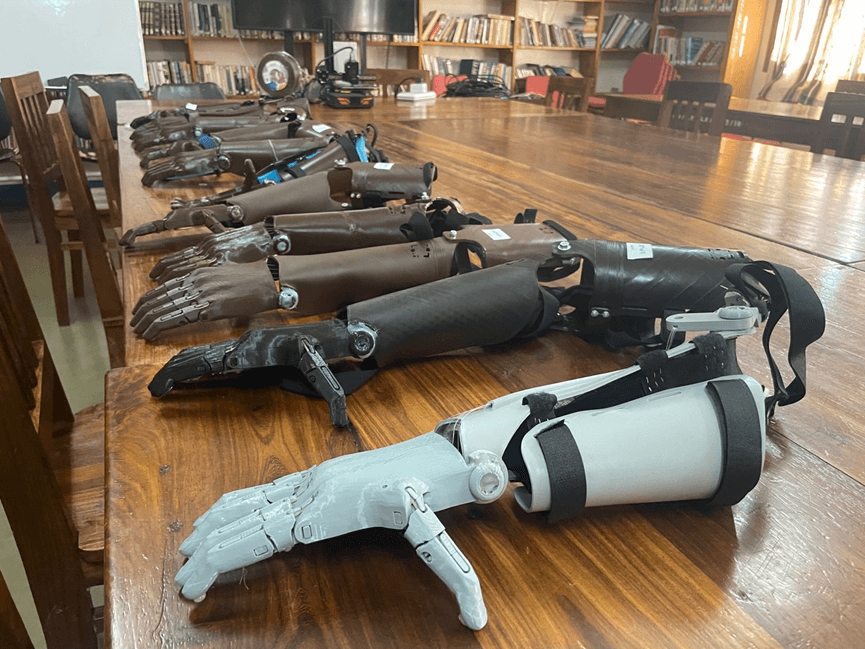Prosthetics, medical, surgical tools, and equipment are extremely expensive. But with 3D printing, it's not only cheaper but also faster and offers advanced customization options.
Resin 3d Print
Through this printing, you'll get a high-resolution print. It's mainly used for smooth-surfaced parts, especially while printing surgical tools or implants. In short, you can make fine-detail applications with resin printing. Creality's most popular resin 3d print incloude the HALOT-MAGE S.
How Is 3d Printing Used In The Medical Field?
There are several things you can make with a 3D printer. These innovations are transforming 3D printing for healthcare. So here's your inspo for the next medical 3D printing project.
3D Printed Prosthetics & Orthotics
Everyone knows how costly traditional prosthetic limbs are. The starting cost is in thousands, and it keeps going up. It's a necessity for growing children who urgently need replacement.
But with 3D printers, you can customize it according to the person's anatomy and preferences. They can be created quickly, and you don't have to break your bank.
Nowadays, 3D printed orthotic braces for spine, knee, or foot support are also printed on demand. It's a relief for people who can't afford hefty medical devices. These 3D printed medical devices are not less than a ray of hope in their lives. Click to learn more about Creality's 3D-printed prosthetic limb project.

Surgical Guides & Tools
3D printed surgical instruments like clamps, retractors, or drill guides can be used in actual operating rooms. However, it's important to sterilize them properly to avoid any risk of contamination.
Surgeons are now even using custom surgical guides. But what's the significance?
These guides are modeled from patient scans. So surgeons can perform surgery for precise operations.
Anatomical Models for Training & Planning
All medical students understand how difficult it is to learn anatomy. But what if you've an exact 3D printed replica of your patient's heart or spine before surgery?
It will not only help students in learning but also help surgeons improve diagnostic tools. As a result, surgeons plan more effectively, operating time reduces, and the chances of success increase.
Casts, Braces & Wearables
Have you ever seen bulky plaster casts?
They are not only heavy but also impact respiration.
3D printing is also providing a solution with 3D printed exoskeletal casts. These are:
-
Lightweight
-
Breathable
-
More hygienic
But make sure that you're using flexible material like TPU and customize it for the patient for better results.
Materials for 3D Printing Medical Devices
You need to understand that in medical-grade 3D printing, biocompatibility is critical.
Make sure that the device is safe for skin contact, resistant to sterilization methods, and strong enough to withstand extreme wear and tear.
The biggest mistake people make when using a 3D printer is ignoring the materials. That's why people get disappointed because their 3D print doesn't look like the vision in their head. So here are some common materials specifically for medical use:
|
Material
|
Key Properties
|
Common Medical Applications
|
|
PLA (Polylactic Acid)
|
Biodegradable, easy to print, rigid
|
Anatomical models, educational tools
|
|
PETG (Polyethylene Terephthalate Glycol)
|
Durable, impact-resistant, chemically stable
|
Orthotic braces, medical equipment housings
|
|
TPU (Thermoplastic Polyurethane)
|
Flexible, skin-safe, abrasion-resistant
|
Splints, soft braces, wearable rehabilitation devices
|
|
Medical-grade Resin
|
High-resolution, sterilizable, precise
|
Surgical guides, dental models, intraoperative tools, 3D printed surgical instruments
|
Choosing the Right 3D Printer for Medical Projects
If you're a beginner or an expert, choosing the right 3D printer will make an incredible difference. You can't compromise on precision or reliability. But how can you choose the right 3D printer? How do you know which printer is ideal for medical projects?
Here are a few things you should notice. It'll help you in making the right decision.
-
Build Volume: For large anatomical models, but ensure you've a large print bed as well.
-
High Resolution: If you're printing intricate tools and guides.
-
Material Compatibility: Printer must support PETG, TPU, and medical-grade resin.
-
Ease of Use: Check for smart features like auto-leveling, smart touch screens, etc.
Creality Printer Recommendations:
If you're still not sure about which printer to choose, then let Creality make it easy for you. For the FDM 3D printer, you'll get two options:
-
Ender-3 S1 Pro: These are compact, versatile, and support flexible filaments like TPU. Perfect for 3D printed orthotics, casts, and educational models.
-
K1 Max: These are ultra-fast with incredible AI camera monitoring and a large print volume. Suitable for complex prosthetics and full-size training models.
Meanwhile, in resin printers, you've an incredible option:
-
HALOT-MAGE S: 14K resolution for ultra-precise surgical tools or fine anatomical replicas. Used for laboratories or professional settings needing high-detail output.
The price range for printers depends on various factors. Check out this blog to know How Much Do 3D Printers Cost.
How to 3D Print Medical Devices Step-by-step Guide
Now that you know about materials, printers, and nitty gritty, it's time to start printing. This simplified guide will help you get started.
Design with CAD Software
Use medical scans (CT/MRI) to create a 3D model. You can even create a custom digital model with software like Fusion 360 or TinkerCAD.
Slice the Model
Now, prepare the model in Slicer. If you've a Creality printer, then use Creality Slicer to convert the 3D file into a model that's ready to be printed.
Remember to do this:
-
Choose an appropriate layer height and infill.
-
Enable support structures for complex geometries.
-
Adjust temperature settings based on the material.
Set up your Creality printer, load the resin or filament, and start printing. In medical applications, reliability and dimensional accuracy are critical.
Post-Processing
-
FDM Prints: Remove supports, sand edges, and disinfect.
-
Resin Prints: Wash in isopropyl alcohol, cure under UV light, and sterilize if required
To Sum Up
It's time to start using the latest technology in the medical field because it'll leave a huge impact on the lives of people.
So whether it's a prosthetic arm for a child, a custom spinal brace, or a model heart to train the next generation of incredible surgeons, 3D printing is changing the medical landscape forever. The best part is that it's opening doors to a human-centered healthcare approach.
Creality doesn't want only a few people to get access to these life-changing tools. We are helping healthcare innovators push boundaries in clinics, universities, and research labs worldwide.
So what are you waiting for?
Be a part of this movement by exploring Creality 3D printers for medical applications. If you've any queries, then don't hesitate to connect with us via the Creality community.
Let's bring your innovative medical projects to life with Creality 3D printers.
